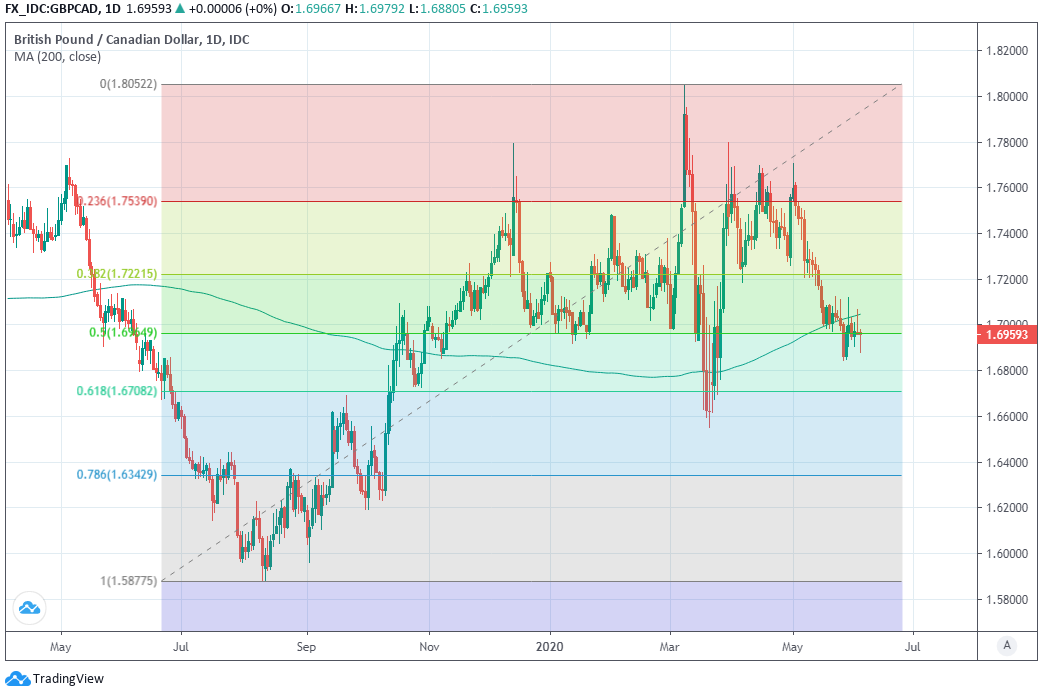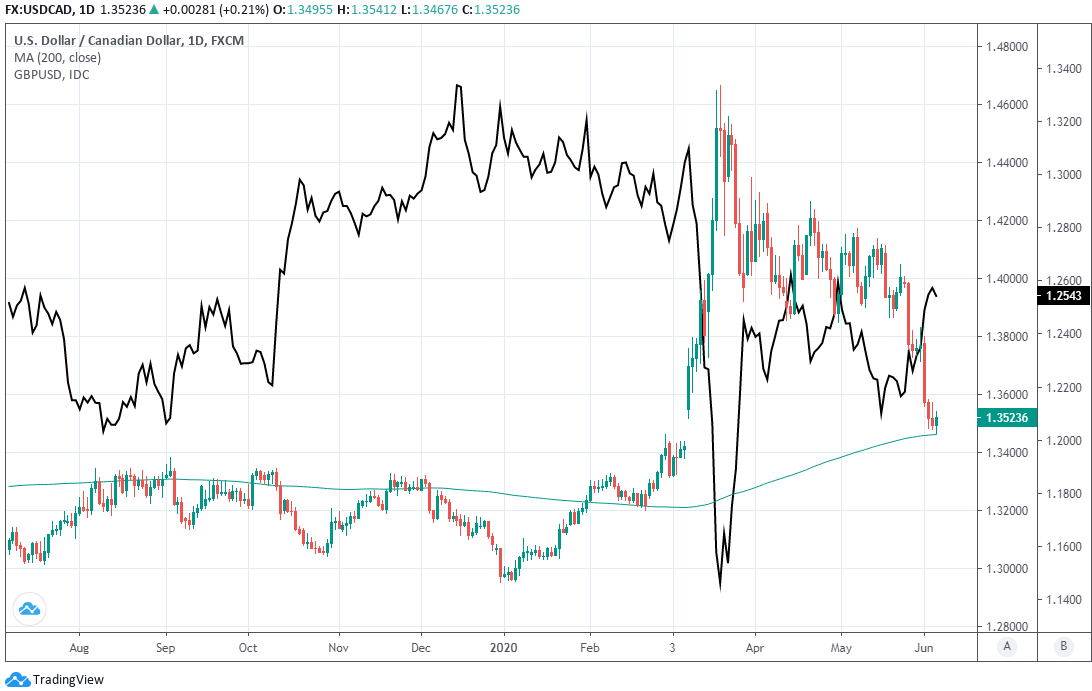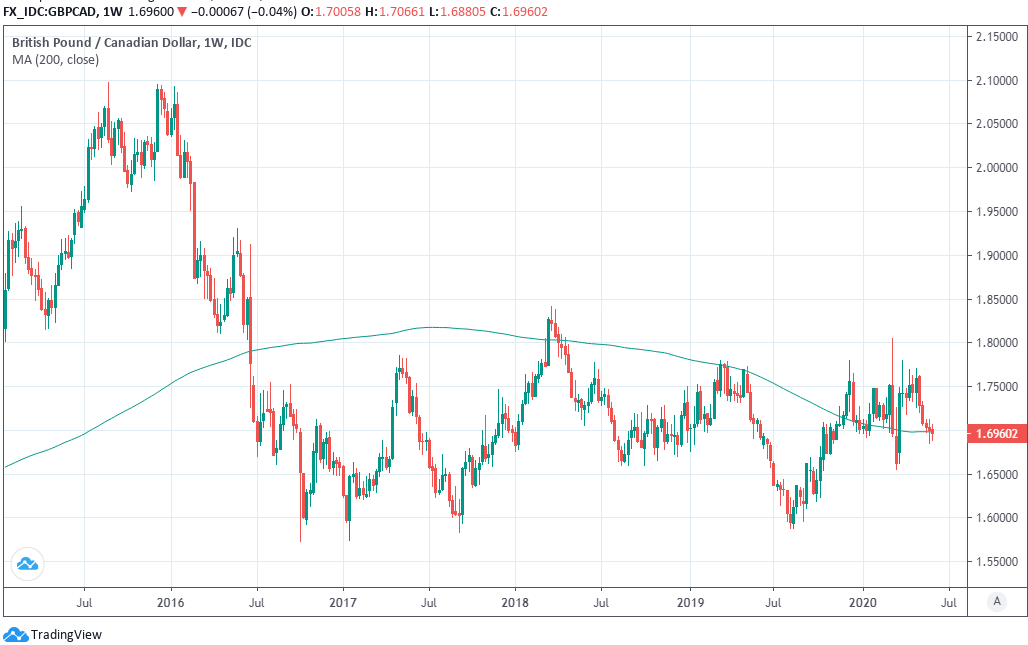Pound-to-Canadian Dollar Rate Facing Long Stretch below 1.70, Forecasts Show
- Written by: James Skinner
-
- GBP may see 1.71 in June, BMO forecasts, as CAD corrects lower.
- But is seen hitting 1.65 by year-end, faces lengthy spell below 1.70.
- As global recovery and better Canadian fundamentals boost CAD.
- While BoE set to weigh on GBP as key Brexit deadlines draw near.

A single oil pump jack in the farm field. Calgary, Alberta, Canada. Image © Adobe Stock
- GBP/CAD at time of writing: 1.6936
- Bank transfer rates (indicative guide): 1.6400-1.6524
- FX specialist rates (indicative guide): 1.6600-1.6850
- More on acquiring specialist exchange rates here
The Pound-to-Canadian Dollar rate is facing a lengthy stretch below the 1.70 handle according to BMO Capital Markets forecasts, suggesting that any improvements seen over the coming weeks could be as good as they get for Sterling denominated buyers of the Canadian currency.
Sterling's decline against the Loonie has slowed this week but the British currency has still underperformed many of its comparable rivals while the Pound-to-Canadian Dollar rate was down by -0.21% for the period on Thursday. Losses continued even as stock markets and commodities came off the boil, enabling the U.S. Dollar to take a breather from seven days of back-to-back declines against its most frequently traded rivals.
The Pound might once have been expected to outperform its Canadian counterpart in a so-called risk-off market where closely-correlated equity benchmarks are lower and the outlook for oil prices is in doubt, but it's been burdened in 2020 by a bevy of risks and macroeconomic ailments that other rival currencies are not saddled with and especially those underwritten by rip-roaring commodities and relatively less problematic public finances.
Those risks combined with investors' eagerness to wager on a robust global economic recovery, which is supportive of the Loonie, explain why some forecasters see the Pound condemned to life below 1.70. Sterling has been breaking down into a new, lower trading range for just more than a month now.

Above: GBP/CAD shown at daily intervals with 200-day moving-average and Fibonacci retracements of 2019 uptrend.
"According to our fair value model, the move lower in USDCAD has been run ahead of correlated fundamentals like commodity price indices, risk appetite measures and interest rate differentials. Our model has fair value base on those factors at 1.39," says Greg Anderson CFA, global head of FX strategy BMO Capital Markets. "Our 3M objective from our last outlook update has already been surpassed with USDCAD falling hard to 1.35 over the past week. We believe that move is a bit of an overshoot that will run out of steam and partially retrace. Our 1M outlook is 1.37. However, we expect USDCAD's fundamentals to push it lower, so we have set our 3M outlook at 1.35."
The USD/CAD outlook matters for Sterling because it is effectively one half of the Pound-to-Canadian Dollar rate, which always closely matches the sum of GBP/USD over CAD/USD.
USD/CAD has fallen -1.94% this week even after Thursday's increase while GBP/USD rose only 1.74%, explaining the fall in GBP/CAD. But BMO foresees a trend toward Canadian Dollar strength this year while the Pound is expected to weaken against both the Loonie and U.S. Dollar.
With a brief run at the 1.71 handle in June put aside, BMO sees the Pound-to-Canadian Dollar rate falling to 1.67 by the end of September and 1.65 by year-end before recovering only as far as 1.68 within the first half of 2021.
All forecasts barring the anticipated June move to 1.71 imply less favourable exchange rates than those available on Thursday, although they are period-end projections and so don't preclude even higher or lower levels from being seen in the interim. Both USD/CAD and GBP/USD have fluctuated by up to 6% in the last quarter while the Pound-to-Canadian Dollar rate has averaged 1.7244 but been as high and low as 1.78 and 1.68 respectively.
"Oil has staged a remarkable comeback, with WCS-grade oil trading at $29. This is nowhere near high enough to make Alberta boom again, but it is high enough to not cause cash flow problems that have been associated with previous USDCAD spikes," Anderson says. "The latest CFTC Commitment of Traders report showed leveraged funds holding 3 times as many CAD shorts as CAD longs. A big block of position seems to have been entered in mid-May around 1.40. Those positions are being squeezed. Canada’s twin deficit fundamentals are strong compared to most OECD countries...CAD should have safe-haven properties that largely offset its pro-cyclical oil correlation."

Above: USD/CAD rate shown at daily intervals alongside GBP/USD (black line).
Canada's Dollar benefits from recovering oil prices and a public balance sheet that's not quite as stretched or risky as that of the UK, but it's also been bolstered this week by the Bank of Canada (BoC), which said "the Canadian economy appears to have avoided the most severe" coronavirus contraction scenario envisaged back in April. The BoC left its cash rate at 0.25% and refrained from any increases to its government bond buying programme.
This has averted fresh pressure on bond yields and helped the Loonie retain its position as one of the highest yielding major currencies. Meanwhile, the Bank of England (BoE) is expected to increase the size of its quantitative easing programme this month, further weighing on already negative bond yields, while also flirting with the idea of negative interest rates. That makes for a stark contrast in fundamentals between the Canadian and British currencies, although one that could grow starker yet.
"The FT ran a story today highlighting the degree to which the so-called "economic hit" from a WTO Brexit would pale in comparison to the economic swings from COVID-19. Brexit and COVID-19 provide an opportunity for a huge economic reset," says Stephen Gallo, BMO's European head of FX strategy.
Brexit trade negotiations are at an important point that could inspire more volatility in the Pound over the coming weeks. The Times suggested Tuesday that European officials were anticipating compromises from the British side in this week's fourth and final round before a soft deadline for progress in trade talks. Although progress toward an agreement could yet be announced by negotiators in Friday's press conference, The Times' story was quickly rebutted by Prime Minister Boris Johnson's office. m
Absent some kind of breakthrough, the Pound might end up paying for increased market fears about the prospect of a 'no deal Brexit' playing out at year-end. At the very least, such concerns would give investors one more reason, in addition to the BoE and any other, to avoid Sterling and consider buying alternatives like relatively unencumbered Canadian, New Zealand and Australian Dollars instead.

Above: GBP/CAD shown at weekly intervals, probing below the 200-week moving-average.









